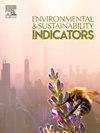GIS-based assessment of soil erosion impact and mitigation strategies for sustainable agriculture in Ghana's most vulnerable region
IF 5.4
Q1 ENVIRONMENTAL SCIENCES
引用次数: 0
Abstract
The study estimated the average annual soil loss for sustainable crop production in the Upper East of Ghana, using the Revised Universal Soil Loss Equation, sensitivity, correlation and regression analyses to understand the factors driving erosion in the area. Rainfall data from Climate Hazards Group InfraRed Precipitation with Station data (CHIRPS) was used to determine the rainfall erosivity, soil erodibility from the Harmonized World Soil Database, the Slope Length and Steepness from the Shuttle Radar Topographic Mission data, the Cover Management and Control Practices from Landsat satellite data from the years 2000, 2010 and 2020. The northeastern region was identified as the most susceptible to soil loss. The region recorded an annual average soil loss of 50.26 tons/ha/yr, 56.50 tons/ha/yr and 39.61 tons/ha/yr in 1990–2000, 2001–2010 and 2013–2020, respectively. A sensitivity analysis showed that C and R factors profoundly impact soil loss in the region. The regression analysis (R-squared = 0.686, n = 1374) revealed that the significant factors influencing soil erosion are slope (p < 2e-16), cover management (p < 2e-16), and support practices (p < 2e-16), while rainfall erosivity (p = 0.37036) and soil erodibility (p = 0.06753) are not significant predictors. Further findings also showed that erosion in the area affects crop production, food security and livelihoods, public health and wildlife. The study recommends a strategic and integrated approach to soil conservation which incorporates more research on sustainable land management, soil health, climate-smart agriculture, and local knowledge for sustainable land management.
求助全文
约1分钟内获得全文
求助全文
来源期刊

Environmental and Sustainability Indicators
Environmental Science-Environmental Science (miscellaneous)
CiteScore
7.80
自引率
2.30%
发文量
49
审稿时长
57 days
 求助内容:
求助内容: 应助结果提醒方式:
应助结果提醒方式:


